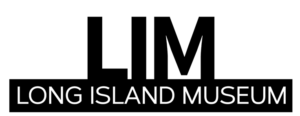
OOOO/OOOO/OOOO/OOOO/OOOO/OOOO
Portfolio Sponsor: Riverhead Toyota
———————————————
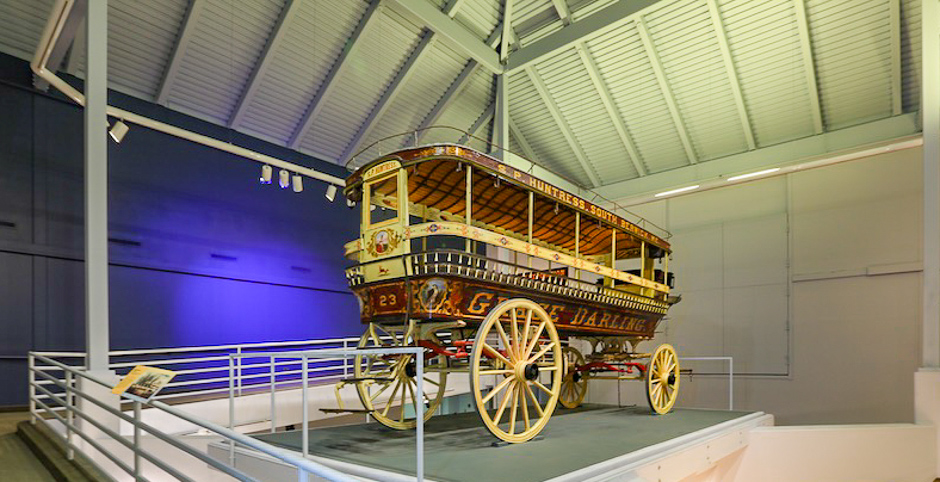
GRACE DARLING. Concord Carriage Builders, Concord, New Hampshire
- – – – – – – – – – – – – – – – – – – – – – – – – – – – – – –
Dorothy and Ward Melville Carriage Collection
The extraordinary collection of horse-drawn vehicles at The Long Island Museum was begun by Ward Melville, a man fascinated by the past and committed to public education. He began in the early 1940s to collect the works of Stony Brook’s nineteenth-century artist William Sydney Mount; by the mid-1940s, he was collecting carriages. Mr. Melville’s interest in collecting paintings and artifacts related to America’s past was part of a trend of interest in American history and artifacts that began in the late nineteenth century and developed rapidly in the twentieth century.
Mr. Melville collected Mount’s paintings and drawings, as well as objects that had belonged to Mount and his family. Assisting Mr. Melville in his art collecting was Richard McCandless Gipson, whose connoisseurship and talent for patient negotiation significantly contributed to the development of Mr. Melville’s superb collection.
Mr. Gipson suggested to Mr. Melville that he might be interested in collecting carriages, observing in a letter to Mr. Melville, “Fine carriages in good condition are becoming increasingly rare. We know how automobiles have driven them off the streets, and leaky barns and neglect have relegated all too many to extinction.” By 1949, Mr. Gipson could write to Mr. Melville, “Again I say that your collection is fast becoming the most important in the country.”
Early in the formation of the collection, the guiding principle was to have the best examples of various types of vehicles, and the growth of the collection included the practice of upgrading by obtaining a better example of a type of vehicle already in the collection and disposing of the lesser example. From the beginning of this new collecting venture, Mr. Melville aimed to make the carriage collection “thoroughly representative of various types of carriages.”
As with his art collection, Mr. Melville always planned to exhibit his carriage collection to the public. The growing collection was stored in the late 1940s in barns at Richard Gipson’s residence in Old Field, and was exhibited to the public there on one occasion–on September 10, 1950, during a tour of historic sites that was sponsored by the Society for the Preservation of Long Island Antiquities. In the same year, working with architect Richard Haviland Smythe, he began plans for converting the deteriorating Stony Brook Hotel building for housing and displaying the carriage collection.
On Saturday, July 6, 1951, the new carriage museum opened with a day-long festival to celebrate the occasion. Eighty of the 125 vehicles in the collection were exhibited in the new facility. The collection included not only horse-drawn vehicles, but accoutrements, such as harnesses, and a library of carriage-related volumes, pamphlets and prints.
Following the 1951 opening of the carriage museum, the collection continued to grow both by purchase and by gift. As private stables were demolished and their contents dispersed, and some museums with vehicles in their collections decided they could no longer house them, additional gifts were made to the new carriage museum.
In 1956, Mr. Gipson wrote to Mr. Melville: “Before 1953, we had been building the basic collection. Since that time, I have been endeavoring to perfect the collection and to search the country exhaustively for rare and early vehicles. Your collection now numbers many rare vehicles and holds its position as the finest and most comprehensive collection in the country….Each vehicle or each group of vehicles has been acquired with a definite purpose, for at all times I have had a well-defined goal of the comprehensive collection before me.”
As the collection’s reputation spread, many requests for information were received by the museum. A list of these correspondents was kept, and in 1960 Mr. Melville invited them to come to the museum to see the collection. The meeting resulted in the founding of the Carriage Association of America, now an international organization of more than 3,000 members.
— The Carriage Collection, copyright 1986, Long Island Museum — Abridged version.
——————————-
Captions / text courtesy of the Long Island Museum.
OOOO/OOOO/OOOO/OOOO/OOOO/OOOO
The GALLERIES
The Museum’s galleries display more than 100 horse-drawn carriages. Going Places features typical carriages used in everyday life on 19th century Long Island, as well as a fiber optic map illustrating the evolution of travel routes from the carriage era to the present day. A Carriage Exposition is modeled after the transportation exhibition at 1893 Chicago World’s Fair. Making Carriages features vehicles made by the Studebaker Brothers, along with an original carriage make shop relocated to the museum from Williamsburg, Massachusetts. The lower level galleries include A Gentleman’s Coach House, European Vehicles Gallery, Carriages for Sport & Pleasure, and Streets of New York, featuring carriages seen on a typical 19th century New York City street.
OOOO/OOOO/OOOO/OOOO/OOOO
1 – GOING PLACES
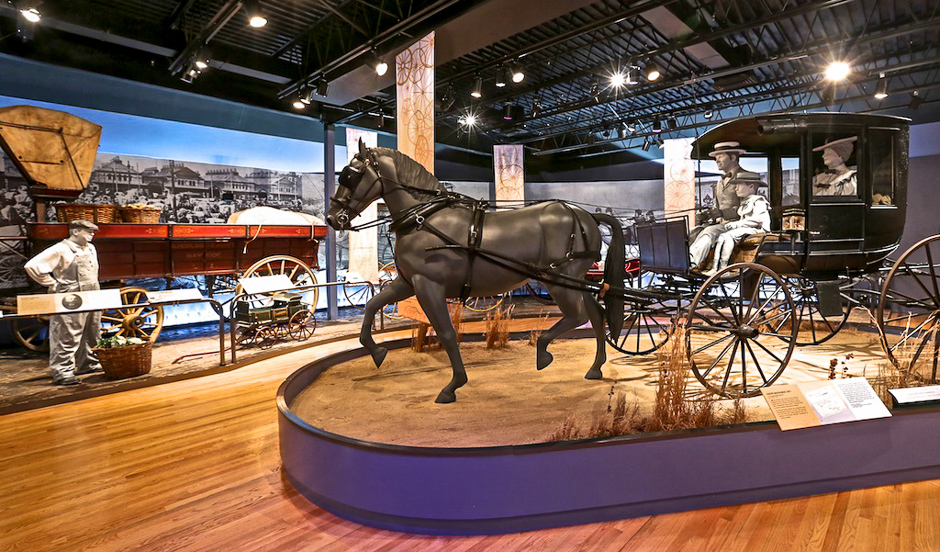
COUPE ROCKAWAY. A.S. Flandrau, New York, NY, 1871.
This vehicle type, known as the rockaway, originated on Long Island. It was named after the village of Rockaway, Queens, then a fashionable beach resort. Carriage shops in nearby Jamaica perfected its design. An enclosed family vehicle, the rockaway’s most distinguishing feature is its roof. The roof extends over the front seat to give protection from the weather to the driver.
OOOO/OOOO/OOOO/OOOO/OOOO
America Gets Moving
Carriages – not cars – once ruled the road. These forerunners of automobiles and trucks were absolutely essential to American life in the 1800s. Carriages came in an amazing assortment of sizes, shapes and finishes. And they had a wide variety of uses. They moved people from place to place, transported goods, demonstrated their owners’ pride and accomplishments and provided new leisure opportunities. But carriages were not for everyone. Owning a vehicle, and the horse or horses to pull it, took a good deal of money. It might surprise you to know that a smaller percentage of the population then owned carriages than now own cars.
The standard of living of Americans improved greatly during the 1800s. As a result, more and more people were able to own vehicles and in turn were able to demand more and better roads. And as roads grew and improved, people could go more and more places and faster. This, in turn, greatly helped the developing American economy, since horse-drawn vehicles often provided the necessary connections between other forms of transportation – trains, canal boats and steamships – to get people and goods from point of origin to final destination.
A time line and a video, courtesy of the History Channel, place the “carriage story” into a broader context of American history, and a colorful interactive map of Long Island presents the changing transportation networks in which horse-drawn vehicles played so important a role. “People stories” complement the vehicles by introducing someone associated with each, including owners, drivers and craftsmen.
OOOO/OOOO/OOOO/OOOO/OOOO
2 – A Carriage Exposition
Selling Carriages to a New American
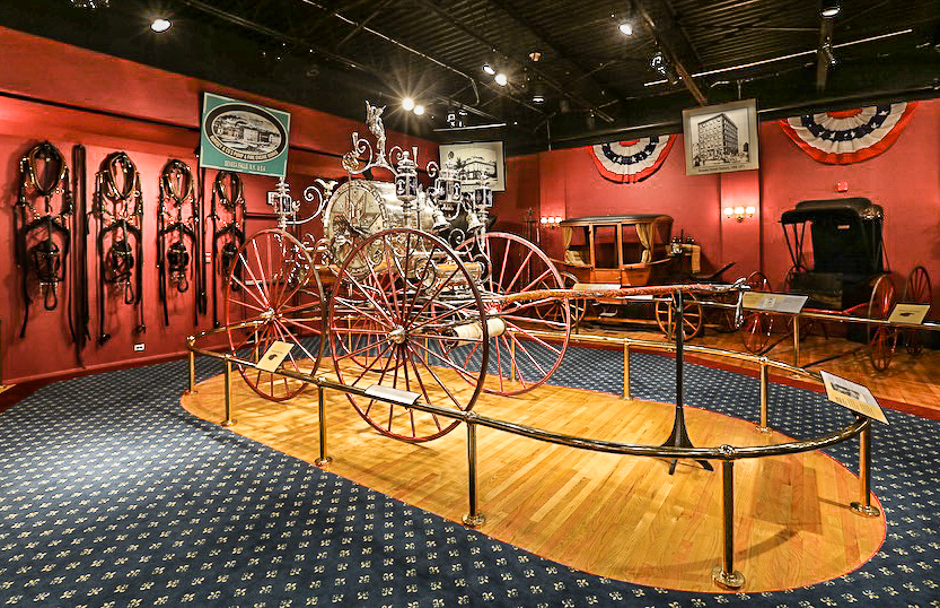
PARADE HOSE CARRIAGE, 1870-1880. Rumsey Mfg. Co., Seneca Falls, NY — Originally owned by Ringgold Hose Company #1, this carriage had silver plating from its axles to the statue of Cupid on top and mirrored on the ends of the hose reel. It was used by the Ringgold Hose Company in parades for over 70 years.
OOOO/OOOO/OOOO/OOOO/OOOO
A Carriage Exposition is inspired by the display of carriages at the 1893 World’s Columbian Exposition in Chicago. From oil lamps to Edison’s electric lights…from farm buggies to Ford’s Model T…nearly everywhere you looked, the United States underwent profound changes between 1865 and 1918.
In 1865, family farms were the country’s economic heart; by 1918, factories had become the nation’s driving economic force. Rapid industrialization and technological change turned out more goods using less labor at lower prices. The resulting new products were marketed through glossy advertising and displays to eager crowds of consumers at fairs, expositions and markets.
The most spectacular display of all was the Chicago World’s Fair of 1893 attended by more than 30 million visitors. Here, along the shores of Lake Michigan, where people saw cultural and technological treasures, they could also see the newest and best in the world of carriages. Carriage entrepreneurs used the fair for the same purposes as other industries – to promote their wares and to sell, sell, sell.
OOOO/OOOO/OOOO/OOOO/OOOO
3 – Making Carriages
From Hometown Shop to Factory
 The Graves Carriage Shop, Williamsburg, Massachusetts
The Graves Carriage Shop, Williamsburg, Massachusetts
Carriage production changed drastically during the 19th century. At its start, the manufacturing of carriages occurred almost exclusively in small shops staffed by skilled craftsmen. By century’s end however, large mechanized factories had all but replaced small carriage shops.
The Studebaker Company serves as an excellent example of the changing economic landscape.
In 1852, with just $ 68 and the craftsman skills taught to them by their father, Henry and Clement Studebaker established a small wagon shop in South Bend, Indiana. Soon business boomed. By the start of the Civil War in 1861, the Studebakers had sufficiently expanded production and gained a reputation for quality to be granted U.S. government contracts for the production of war-related supply wagons, gun carriages and ambulances. During the remainder of the 19th century, the company continued to grow with Studebaker dealers and distributors popping up throughout the United States and in several foreign countries.
Studebaker was among the first carriage companies to experiment with the “horseless carriage.” The company first produced a series of electric automobiles stating in 1902 and in 1904 switched to the production of gasoline powered vehicles. While Studebaker still manufactured wagons and carriages, their appeal gradually waned. In 1911, for example, the company’s gross sale for automobiles was more than triple that of their total sales of wagons and carriages.
OOOO/OOOO/OOOO/OOOO/OOOO
4 – The Streets of New York
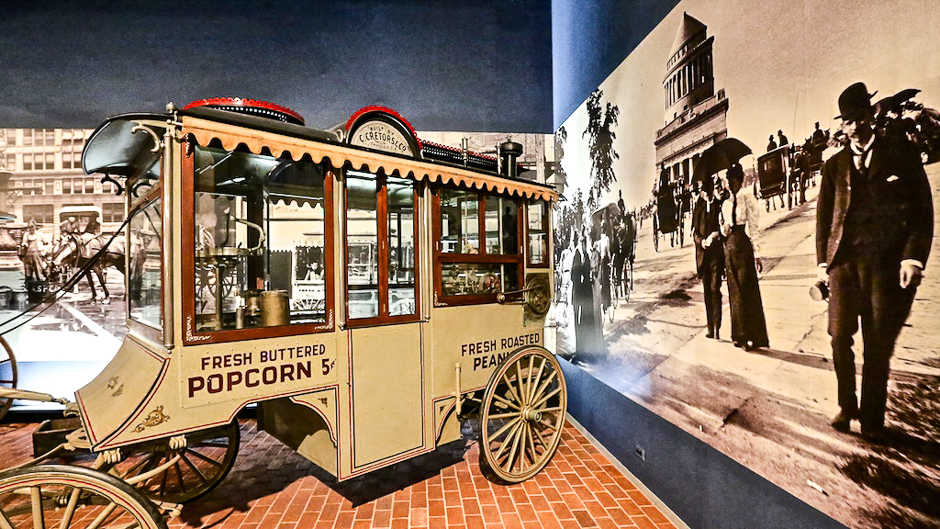
POPCORN WAGON, 1907. C. Cretors & Company, Chicago.
In the late 1800s, horses and carriages ruled America’s city streets…and what a scene it was! From sunup to sundown, cities buzzed like beehives. In New York, big horse-drawn omnibuses (the city buses of their day) and hacks (cabs) rumbled over Broadway. Yelling vendors, bellowing stagecoach drivers and thundering wagon wheels on cobblestones formed the urban soundtrack. Crossing the street was an even bigger adventure than it is now: amidst the jostling vehicles, New Yorkers had to step around dung heaps from the city’s working horses.
Carriages were everywhere in the city and used for many purposes. Delivery wagons contained fresh groceries, newly-cut lumber, supplies of every description. Elegant private coaches moved gracefully down Fifth Avenue, carrying rich residents to the office, the opera or a fancy meal. Heavy steam pumpers put out countless raging fires in the city’s tenements. And many immigrant workers relied on simple two-wheel cars, moved by their own muscle.
New York was also at the center of the carriage-making industry. In 1859, there were over 40 carriage manufacturers in the city, selling nearly 5,000 vehicles per year. Those numbers continued to rise over the next decades. By 1880, Manhattan and Brooklyn together had 249 carriage makers. Even after the rise of motorized streetcars, the subway, and automobiles in New York, carriages continued to play an important – if ever-diminishing – role. Into the 1940s, horse-drawn vehicles still delivered milk, ice, and other basic items in spots where early trucks had trouble maneuvering. But the days of a busy, noisy, and endless procession of horse-drawn carriages were long gone.
—————— RECENT ADDITION TO THE GALLERY ——————

STREETCAR, C. 1887
J. G. BRILL COMPANY
PHILADELPHIA, PENNSYLVANIA
————
DONATED BY: ALEXANDER POLLOCK, ARCHITECT, 2019
The ancestor of modern urban public transit is the horse-drawn streetcar, or horsecar. One or two horses pulled this type of vehicle on rails along a regular route down city streets. The rails offered a smoother ride than horse-drawn omnibuses and coaches, and the reduced friction allowed the horses to pull a heavier load with less effort. New York City started the first horsecar line in the US, in 1832. By 1870 New Yorkers were taking more than 100 million horsecar trips a year. The development of electric streetcars in the 1880s soon led to most cities scrapping their horsecars by the start of the twentieth century. New York City retired its last horsecar in 1917.

For much of the nineteenth century, the horsecar was how most urban residents experienced the era of horse-drawn transportation. In contrast to the smaller, private vehicles in this gallery, the horsecar offered few comforts. Riders shared unpadded wooden benches, with roll-down side curtains offering some protection during inclement weather. But it was cheap, efficient transportation, and facilitated travel between city neighborhoods for people going to work, shopping, and leisure activities.

Two scenes from Hello, Dolly! with the streetcar and Water Matthau and Barbra Streisand. © 20th Century Fox.
This streetcar was built in the late 1880s by the J. G. Brill Company of Philadelphia, and shipped to Los Angeles, where it spent its entire working life. The open sides identify it as a “summer” streetcar, though Southern California’s mild climate allowed it to be used year-round. The adjacent photograph depicts a similar Los Angeles streetcar. Note the bell around the neck of one horse, which alerted pedestrians and other vehicles to its approach. Decades after being retired and then part of a private transportation collection, this streetcar was repainted to resemble a New York City streetcar for the film Hello, Dolly! (1969). It received its current painted livery – for the Central Railway Company of Los Angeles – around 1984.
—– Courtesy of the Long Island Museum
OOOO/OOOO/OOOO/OOOO/OOOO
5 – Driving for Sport and Pleasure

TALLY HO, 1875. Holland & Holland Builders, London, Great Britain. Gift of the Museum of the City of New York.
Racing at breakneck speed around a curved dirt track…parading in well-appointed splendor through a big city park…sleighing through the snow and ice on a crisp winter’s day – vehicles for sport and pleasure provided escapes into life’s most enjoyable diversions. The vehicles seen here include winter sleighs, pleasure wagons, and other carriages made for carrying well-to-do passengers to fun-filled destinations like resorts and country picnics.
Vehicles for sport and pleasure looked and functioned differently from work vehicles. They were often used in places removed from the city, especially in parks, estates, and on country roads. When Central Park opened in 1858, New York City explicitly prohibited omnibuses and express wagons from entering the park, as well as “any cart, dray, wagon, truck, or other vehicle carrying goods”; only non-work-related carriages were permitted.
In the 1800s, carriage makers designed and made pleasure vehicles that were faster and more comfortable, even on rough and uneven roads. Innovations to wheels, suspensions, shock absorption and interior comfort all improved the ride.
Owner-driven pleasure vehicles showcased the skills and mastery of their drivers, an ability to handle both the horse and vehicle that earned them an honored status as a “whip.” Whether driving a carriage harnessed to a single horse, a pair, a tandem, or four-in-hand, the “whip” needed to be able to manage all sorts of challenges. High status was also achieved through a fashionable “turnout”: the suitable standard and properly-dressed drivers, grooms, passengers, and horses, as well as the properly chosen harnesses, fittings and other accessories for specific pleasure vehicles.
OOOO/OOOO/OOOO/OOOO/OOOO
6 — A Trip to Yesterday
Long Island in the Carriage Era

In this exhibition, you begin your trip to the lost Long Island of a century ago through a re-creation of the old Stony Brook Station and see the actual Depot Wagon in which turn-of-the-century guests were transported from the Station to Stony Brook and other local villages.
The Village itself consists of two-thirds-scale structures based on local buildings, circa 1900: the Old Stony Brook Post Office, the E. E. Topping Store (Stony Brook), and the Samuel West Blacksmith Shop (Setauket), in addition to the Train Station.
OOOO/OOOO/OOOO/OOOO/OOOO
7 — Gentleman’s Coach House Gallery
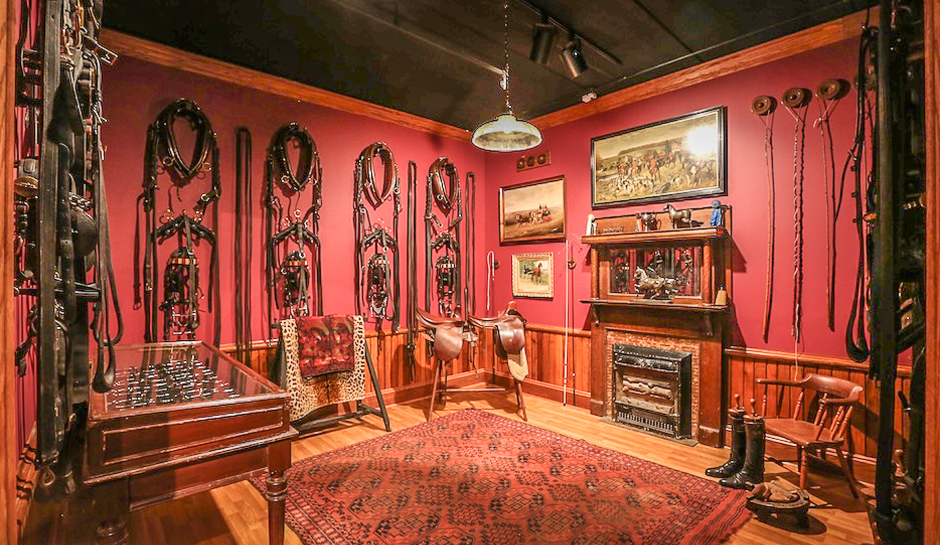
Key: center — Side saddles, c. 1900 / left of center — Carriage lap robes, c. 1890 / far left of center — Buxton carriage bits, c. 1890 / left wall — Four-in-hand harness for a road coach, c. 1900 / center, far wall — Four-in-hand harness for Pioneer road coach, c. 1900 / right of center, top — James Lynwood Palmer, Driving at Shinnecock Hills, 1892 / right of center, bottom — Frederick Mortimer Lamb, Lady Driving a Buggy, 1903 / over mantel — Gustav Muss-Arnolt, Meadow Brook Hunt, 1885 / right wall, near center — Light carriage harness, c. 1930 / far right wall — Pony harness, c. 1900.
——————
Early 20th century tack room (note the electric light at top), with the fireplace used to keep the leather harnesses, saddles, and boots dry. Also, two wool lap robes (for riding in open horse-drawn vehicles), whips, and a display case of horse brasses or bits.

“A team well harnessed and put together,” went one popular saying, “is half driven.” If so, the tack (or harness) room’s place in a carriage house took on even greater importance. The equipment stored in a tack room was essential to the “full turnout,” the properly prepared display that featured harmoniously dressed and equipped carriages, horses, passengers, and servants.
Tack rooms required the driest, cleanest conditions possible, as the equipment they stored was easily damaged by dampness and dust. A fireplace or stove was a key feature in these rooms, to protect leather from mildew and metal parts from rusting or tarnishing.
Racks of saddles, whips, and lap robes were often on view here. Harnesses and bridles were carefully arranged according to size and hung from the wall brackets. Small amounts of polish and varnish were also on hand. Rows upon rows of accessories carefully massed together this way — like Victorian art collection — were a point of pride for the estate owner.
OOOO/OOOO/OOOO/OOOO/OOOO
8 — European Vehicles Gallery
From parlors decorated with Old Master paintings to coach houses resembling castles, America’s Gilded Age elites craved European cultural refinements. Indeed, most styles of American luxury vehicles had their origins in the Old World – landaus, caléches, broughams, and chariots d’ Orsay, to name a few. Ornate interiors, elaborate paint schemes, and even coats-of-arms seen on the panels of European coaches were adapted by Americans, in order to associate their vehicles with old money, blue blood and good taste. In 1878, New York carriage maker Ezra Stratton wrote that the super-rich were “aping the European fashion, now driving through our streets in the most approved style.”
But imitation stopped short of duplication. Traveling overseas, America’s wealthiest marveled at the startlingly different carriages they saw in London’s Hyde Park and along the Champs-Élysées in Paris. While their basic constructions were similar, European luxury vehicles, such as these, were heavier and featured more ornate ornamentation – more extensive use of gilding, more elaborate paint schemes, and more references to allegorical and classical figures.
Most of the European vehicles seen in this gallery were used by aristocrats or high officials on streets and promenades near their palaces and other halls of power. Four of the carriages were owned by Prince Adalbert of Bavaria (1828-1875), used in his lifetime at Nymphenburg Palace in Munich. After his death, they sat on the palace grounds gathering dust through two World Wars and did not arrive in the United States until 1959, when Dieter Holterbosch, a German executive with family ties to the Bavarian royals, purchased and displayed them at his Long Island estate at Belle Terre. He contributed them to this museum in 1966.

BERLIN COACH, ca. 1775-1785. Unknown maker, France.
The design of the Berlin coach, of Prussian origin, represented a major innovation in carriage construction. The body of the vehicle was hung from leather straps or thorough braces, creating a smoother and more comfortable ride. This feature also made the vehicle more maneuverable than its fixed suspension predecessors. This technology would be used later in other European and American horse-drawn vehicles, before the advent of springs.
This coach was sent from France to Rome in 1785, where it was used by Cardinal Pianetti, Pro-Governor of Rome under Pope Pius IX. Much later, Colonial Williamsburg used it in its film The Making of a Patriot.
OOOO/OOOO/OOOO/OOOO/OOOO
9 — Children’s Vehicles

Vehicles designed for children’s pleasure, pulled by people, ponies, goats, or dogs, were miniature versions of vehicles used by adults for both work and pleasure. They were made my major carriage manufacturers, as well as by firms specializing in children’s carriages, sleighs and sleds. These miniature vehicles were toys, but they also offered children the practical experience of handling reins, and sometimes the pleasure of driving.
OOOO/OOOO/OOOO/OOOO/OOOO
LONG ISLAND MUSEUM 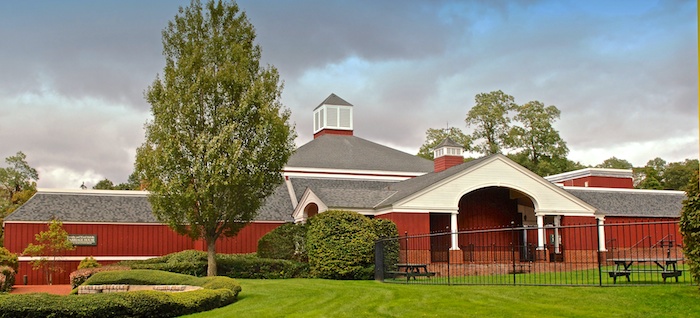
Long Island Museum, 1200 NY-25A, Stony Brook, NY 11790
OOOO/OOOO/OOOO/OOOO/OOOO
BEGIN YOUR MUSEUM VISIT HERE
——————
1. Visitors Center/History Museum 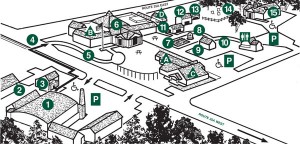
Ticket sales, Museum Gift Corner, Bayman’s Art decoy gallery, changing exhibitions on American history and art
2. Mrs. Frank Melville Gardens
3. Gift Shop
The Gift Shop is currently closed. Plans are underway to renovate with a goal of reopening in the future.
4. Traffic Light and Crosswalk
Visitors must cross Route 25A at the traffic light to tour the Carriage Museum, Art Museum and historic structures. Follow the sidewalk in front of the Gift Shop to the traffic light, push the button and cross when the WALK signal appears.
5. Walkway to Carriage Museum
6. Dorothy and Ward Melville Carriage House (Carriage Museum)
Ten galleries display more than 100 horse-drawn carriages. Going Places features typical carriages used in everyday life on 19th century Long Island, as well as a fiber optic map illustrating the evolution of travel routes from the carriage era to the present day. A Carriage Exposition is modeled after the transportation exhibition at 1893 Chicago World’s Fair. Making Carriages features vehicles made by the Studebaker Brothers, along with an original carriage make shop relocated to the museum from Williamsburg, Massachusetts. The lower level galleries include A Gentleman’s Coach House, European Vehicles Gallery, Carriages for Sport & Pleasure, and Streets of New York, featuring carriages seen on a typical 19th century New York City street.
7. Emma Lee Blackford Rockwell Herb Garden and Pamela Friebely Garden
Created and maintained by the North Suffolk Garden Club
8. Beaux-Arts Fountain, 1880
This 20-ton beaux arts fountain once stood at the corner of Madison Avenue and 23rd St. in New York City, a gift to the city from Olivia Phelps Stokes, a charter member of the American Society for the Prevention of Cruelty to Animals. She commissioned the fountain so that horses traveling Madison Ave. would have a source of water.
9. Nassakeag One-Room Schoolhouse, 1877
Serving the children of South Setauket from 1877 until 1919, the school accommodated up to 30 students ranging from 5 to 15 years of age. Today is serves as the venue for our School Days program, teaching Long Island students about school and farm life in 1850.
10. Outdoor Privy, c. 1935
The privy was originally located on the Edward Guzda farm in Miller Place. It is no longer a functioning privy. (We have indoor plumbing now!)
11. Samuel H. West Blacksmith Shop, c. 1875
Originally located off Main Street in nearby Setauket, the shop includes West’s forges and tools. The shop was in use from 1875 until West’s retirement in 1930. Today it’s an integral part of our Wagons West program designed for school groups.
12. Williamson Barn, 1794
The barn was originally located on the Stony Brook farm of Jedediah Williamson, a Revolutionary War hero who made his living as a farmer, millwright and carpenter. The barn is currently closed for renovation.
13. Smith Carriage Shed, 1867
Originally located on the Timothy Smith farm in nearby St. James, the shed was used by parishioners to protect their carriages from the weather while attending services at the St. James Episcopal Church. The wrought iron rings at the back of the shed were used for tying up the horses.
14. Smith-Rudyard Burial Ground, 1796
The burial ground was established by the Smith and Rudyard families, early settlers on what is now museum grounds. The headstones date from 1796 to 1865. Please don’t climb the fence.
15. Art Museum
Two galleries feature changing exhibitions on American art and history.
~~~~~~~~~~~~~~~~~~~~~~~~~~~~~~~~~~~~~~
For Additional Carriages, Please Visit AAQ’s
Long Island Museum — The Carriage Collection
For More Information, Please Visit
www.longislandmuseum.org
——————-
Photographs © Jeff Heatley.
Rendering of the Carriage Museum — Courtesy of the Long Island Museum
~~~~~~~~~~~~~~~~~~~~~~~~~~~~~~~

Exclusive Portfolio
——————–
Portfolio Sponsor: Riverhead Toyota
———————————————
===============================================

AAQ / Resource: Riverhead Toyota
______________________________________________________
